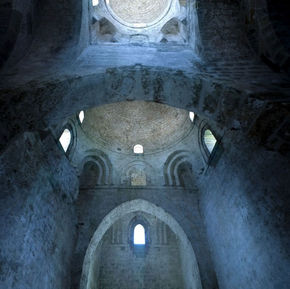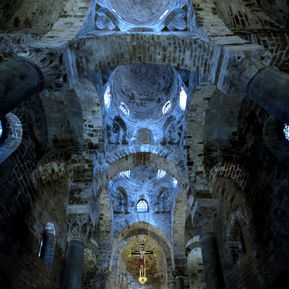FOTOTECA SIRACUSANA
PHOTOGALLERY - FOTOGRAFIA VINTAGE - BIBLIOTECA TEMATICA - CAMERA OSCURA B&W - DIDATTICA
SCRIPTPHOTOGRAPHY
Francesco FERLA (Italia)

FRANCESCO FERLA
“A ognuna delle genti venute armate di bellicosi intenti, il cuor si sciolse in fronte a sì tale bellezza che presto, deposta la voglia del dominio, anch’esse vollero concorrere a donarne in tal misura da sfidare Dio”. Così Goethe, in poco più che un aforisma, descrive la ricchissima, strabordante testimonianza storico-artistica lasciata in eredità da chiunque abbia governato la Sicilia. Raccontare la Sicilia è raccontare una storia che è venuta a patti con se stessa, dove ogni eco mediterraneo ha dimora e dove tutto è illuminato da un sole che trasumana le cose, la gente, i monumenti, i palazzi, le chiese. Raccontare la Sicilia, si è detto, non è facile, è impresa gloriosa e dolente, è insieme un grido e un lamento. Ha detto lo scrittore Sebastiano Aglianò che “ciò che altrove è indifferente, qui è divino”. Ma il “divino” di cui parla Aglianò si declina sempre, e con una ferma costanza, nel suo ribaltamento profano: più dalla Sicilia si è lontani e più la si ama. Il fotografo palermitano Francesco Ferla confessa il suo amore sterminato proprio alla distanza. Come molti dei suoi figli l’isola lo ha spinto in un altrove dove distillare una nobilissima nostalgia. Sentimenti contrastanti, come il sole, la terra e il mare; come il giorno e la notte; come il vento di Scirocco e poi il Maestrale. Tutto si alterna, la voglia di fuggire cede il passo al desiderio del ritorno. Ha detto un notissimo fotografo siciliano, a proposito di sentimenti contrastanti verso l’isola, gli stessi che inducono molti ad abbandonarla, che “dalla Sicilia si scappa a gambe legate”: per quanto ci si possa dire distanti dalla propria terra essa ti ha pervaso dalla nascita, ti ha legato stretta a sé e non ti lascia più. Francesco Ferla è tra questi. E non c’è fotografia dalla quale non traspaia “quel dolore dolcissimo e infido che si chiama nostalgia”. Ma con una differenza. Al rammarico di una terra che spesso disconosce se stessa, che sovente umilia i suoi figli migliori Ferla risponde nel più nobile dei modi, ponendo agli occhi di tutti un patrimonio artistico che non ha pari in nessun altro luogo. Ferla racconta bellezza. E storia. E cultura. Ferla racconta le meraviglie di un “divino edificato”, di una spiritualità che ha voluto tramandarsi attraverso la ricchezza simbolica e in cui le maestranze umane si sono compiaciute nel versare una smisurata bellezza. In ogni secolo. Sotto ogni dominazione. Sempre. Le immagini che vedete sorprendono. Sorprende innanzitutto la passione con cui Ferla si accosta a una narrazione che fuoriesce dai confini meramente architettonici per introdurci nell’esaltazione quasi metafisica di un luogo sacro come nucleo identitario. Che siano le facciate delle bellissime chiese barocche, stile che qui in Sicilia precipita dopo gli sconvolgimenti tellurici sul finire del XVII secolo, o i meravigliosi interni, Francesco Ferla non rinuncia al suo stile personale, drammatico e lirico come la natura d’ogni siciliano. La ricchezza sorprende e ci avvicina alla dimensione dello spirito mentre ancora più struggente si fa il canto d’un amore reso doloroso da una distanza, la stessa che forse ci permette di vedere meglio le cose della vita. C’è nel lavoro di Ferla una “luce pittorica”, un versante cromatico imprescindibile e che dialoga magnificamente ed esalta gli edifici sacri: l’oro Bizantino è un cielo celeste, un’aspirazione all’elevazione e osservarlo sulle volte è un invito al sacro. Ma il turbamento prosegue all’esterno: cieli perdono il ruolo di fondo per divenire drammaticamente vivi mentre li vediamo interagire con lo spazio. La Sicilia è questa. Ferla ne è consapevole e il suo è il tentativo di fornire uno specchio nel quale la sua terra possa specchiarsi e finalmente mostrarsi per quello che è: la terra dove Dio ha imparato a costruire le sue case. E queste “case” di Dio, così come ce le racconta Ferla, ci appaiono nuove, illuminate da una nuova luce, ritrovate. Ecco, “ritrovate” è probabilmente il termine giusto: in fondo l’uomo scopre solo quello che conosce. A Francesco Ferla, al suo meticoloso lavoro, dal quale come si è detto traspare per la Sicilia un amore sconfinato, va il nostro ringraziamento al pari di ogni persona d’ingegno che con i loro occhi hanno visto, hanno dipinto per noi, hanno scritto per noi e fotografato per noi una Sicilia spesso vilipesa e dimenticata.
Giuseppe Cicozzetti
foto Francesco Ferla
"To each of the people who came armed with bellicose intent, the heart dissolved in the face of such beauty that soon, having set the desire for domination, they too wanted to contribute to giving it to challenge God". So Goethe, in little more than an aphorism, describes the very rich, overwhelming historical-artistic testimony left in heritage by anyone who has governed Sicily.
Telling Sicily is telling a story that has come to terms with itself, where every Mediterranean echo has its home and where everything is lit by a sun that transhumes things, people, monuments, palaces, churches. Telling Sicily, it has been said, is not easy, it is a glorious and painful enterprise, it is both a cry and a lament.
The writer Sebastiano Aglianò said that "what is indifferent elsewhere is divine here". But the "divine" of which Aglianò speaks is always declined, and with a firm constancy, in its profane overturning: the more you are far from Sicily, the more you love it. The Palermo photographer Francesco Ferla confesses his love exterminated just at a distance. Like many of his sons, the island has pushed him into an elsewhere where to distill a very noble nostalgia. Contrasting feelings, like the sun, the earth and the sea; like day and night; like the wind of Scirocco and then the Mistral.
Everything alternates, the desire to escape gives way to the desire for return. Said a well-known Sicilian photographer, about conflicting feelings towards the island, the same ones that induce many to abandon it, that "from Sicily you run away legs tied": as far as you can say distant from their land it has pervaded you since birth, he has tied you close to himself and no longer leaves you. Francesco Ferla is among these. And there is no photograph from which does not transpire "that very sweet and treacherous pain called homesick".
But with a difference. To the regret of a land that often disregards itself, which often humiliates its best children Ferla responds in the noblest of ways, placing in the eyes of all an artistic heritage that has no equal anywhere else. Ferla tells beauty. And history. And culture. Ferla recounts the wonders of a "built divine", of a spirituality that wanted to be handed down through the symbolic richness and in which the human workers were pleased in pouring a boundless beauty. In every century. Under every domination. Always. The images you see are surprising. First of all, the passion with which Ferla approaches a narration that emerges from merely architectural boundaries to introduce us into the almost metaphysical exaltation of a sacred place as an identity nucleus.
Be it the fronts of the beautiful baroque churches, a style that here in Sicily precipitates after the earthquakes in the late seventeenth century, or the wonderful interiors, Francesco Ferla does not give up his personal style, dramatic and lyrical like the nature of every Sicilian. Wealth surprises us and brings us closer to the dimension of the spirit, while the song of a love made painful from a distance, the same that perhaps allows us to see the things of life better, becomes even more poignant. There is in Ferla's work a "pictorial light", an indispensable chromatic aspect that magnifies and magnifies the sacred buildings: Byzantine gold is a celestial sky, an aspiration to elevation and observing it on the vaults is an invitation to the sacred.
But the disturbance continues outside: skies lose the basic role to become dramatically alive while we see them interacting with space. This is Sicily. Ferla is aware of this and her attempt is to provide a mirror in which her land can mirror itself and finally show itself for what it is: the land where God has learned to build his houses. And these "houses" of God, as Ferla tells us, appear to us new, illuminated by a new light, rediscovered. Here, "find again" is probably the right term: after all, a man discovers only what he knows.
To Francesco Ferla, to his meticulous work, from which, as has been said, a boundless love shines through Sicily, our thanks go to the same level as any talented person who with their eyes saw, painted for us, wrote for us and photographed for us a Sicily often vilified and forgotten.
Giuseppe Cicozzetti
foto Francesco Ferla








